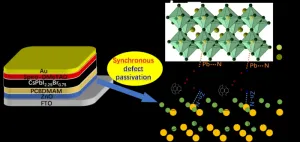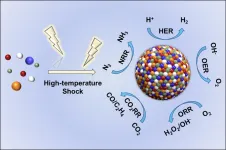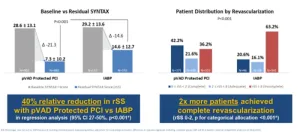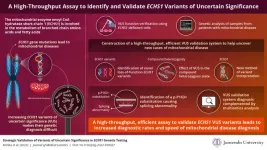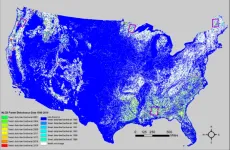(Press-News.org) Biodiversity loss ranks among the top three risks to humanity, as stated in the 2023 World Economic Forum Global Risks Report. Understanding biodiversity's basic building blocks is essential to monitor changes, identify influencing factors, and implement appropriate policies. However, much of terrestrial animal diversity, including insects, remains unknown or "dark taxa."
For example, the global biodiversity information portal GBIF has nine times more information on birds than insects and arthropods, despite birds only accounting for 0.2% of biodiversity. Prof. Rudolf Meier, head of the Center for Integrative Biodiversity Discovery at the Museum für Naturkunde Berlin, highlights the importance of this study in addressing this deficit for effective nature conservation. He emphasizes the need to learn more about insects, as their combined biomass and biodiversity far surpass that of all vertebrates, and they are crucial for survival.
To determine the global taxonomic composition of flying insects, researchers used Malaise traps. These standardized traps are widely employed in global biomonitoring programs. However, analyzing samples is challenging when examining individual insects. Thanks to recent advances in sequencing technologies, biodiversity can now be estimated with "DNA barcodes".
Researchers used DNA barcodes to assign 225,261 specimens to 25,000 species to 458 families. Dr. Amrita Srivathsan, the study's lead author, noted the surprising finding that 10-20 families dominate flying insect communities worldwide. This is remarkable as samples were collected from various climates and habitats like tropical rainforests, montane forests, cedar savannas, scrub forests, thorn fields, mangroves, and swamps, with only Australia and Antarctica not being sampled.
Describing insects is a major challenge in understanding life on Earth, with over 80% still undescribed. The authors emphasize that a large fraction of terrestrial animal biodiversity remains unknown to science and will continue to be, unless "dark taxa" become a priority target in biodiversity research.
Publication: Srivathsan, A.; Ang,Y.; Heraty, J.M.; Hwang, W.S.; Jusoh, W. F.A.; Kutty, S.N.; Puniamoorthy, J.; Yeo,D.; Roslin, T.; Meier,R. (2023): Convergence of dominance and neglect in flying insect diversity. Nature Ecology & Evolution
DOI: 10.1038/s41559-023-02066-0
END
Biodiversity discovery: Unknown species ("dark taxa") drive insect diversity
20 insect families globally account for 50% of flying insect biodiversity, whether in local meadows or tropical forests
2023-05-18
ELSE PRESS RELEASES FROM THIS DATE:
Climate change to push species over abrupt tipping points
2023-05-18
Climate change is likely to abruptly push species over tipping points as their geographic ranges reach unforeseen temperatures, finds a new study led by a UCL researcher.
The new Nature Ecology & Evolution study predicts when and where climate change is likely to expose species across the globe to potentially dangerous temperatures.
The research team from UCL, University of Cape Town, University of Connecticut and University at Buffalo analysed data from over 35,000 species of animals (including mammals, amphibians, reptiles, birds, corals, fish, cephalopods and plankton) and seagrasses from every continent and ocean basin, alongside climate projections running up to 2100.
The ...
Engineering: The house that diapers built
2023-05-18
Up to eight percent of the sand in concrete and mortar used to make a single-story house could be replaced with shredded used disposable diapers without significantly diminishing their strength, according to a study published in Scientific Reports. The authors suggest that disposable diaper waste could be used as a construction material for low-cost housing in low- and middle-income countries.
Disposable diapers are usually manufactured from wood pulp, cotton, viscose rayon, and plastics such as polyester, polyethylene, and polypropylene. ...
Why do Japanese teachers seem unready to teach critical thinking in classrooms?
2023-05-18
Globally, critical thinking (CT) is regarded as a highly desirable cognitive skill that enables a person to question, analyze, and assess an idea or theory from multiple perspectives. CT has become an integral and mandatory part of global educational curricula, but its definition varies across contexts and cultural backgrounds.
To assess the implementation of CT, the Organization for Economic Cooperation and Development (OECD) conducts the Teaching and Learning International Survey (TALIS). In a 2018 survey (TALIS 2018), only 12.6% of lower secondary ...
Boosting solar cell energy capture efficiency with a fullerene-derivative interlayer
2023-05-18
Solar cells are a critical component to the transition to renewable energy sources, and enhanced power conversion efficiency (PCE), or amount of power captured with a given amount of sunlight, increases the practicality of solar power in a society with high energy demands. Perovskite solar cells that use all-inorganic perovskite light-absorbing materials are more thermally stable than organic-inorganic hybrid counterparts, but suffer from lower PCE. Researchers have overcome this hurdle in all-inorganic perovskite solar cells ...
Children’s Cancer Research Fund backs cutting-edge leukemia research at UVA
2023-05-18
Children’s Cancer Research Fund has awarded $250,000 to an innovative new approach to treating leukemia – blood cancer – being developed at UVA Cancer Center.
The grant to John H. Bushweller, PhD, of the University of Virginia School of Medicine, is part of the national nonprofit’s efforts to accelerate the development of new and better treatments for difficult-to-treat cancers.
“This funding makes it possible to continue developing a novel approach to treatment for a form of pediatric leukemia with a very poor prognosis,” said Bushweller, of UVA’s Department of Molecular Physiology and Biological Physics. “For ...
Research to improve quality of stroke care is advancing but gaps exist
2023-05-18
INDIANAPOLIS – Every 40 seconds, someone in the U.S. has a stroke. Every 3.5 minutes, someone in the U.S. dies of a stroke. Stroke patients have multifaceted needs, requiring complicated care delivered by multidisciplinary teams.
In the journal Stroke’s annual review of quality improvement advances in stroke care studies, Regenstrief Institute Research Scientist Dawn Bravata, M.D., and colleagues update researchers, clinicians and healthcare administrators on advances in the field, highlighting the challenges of scalability and sustainability.
“Quality improvement exists to ensure that every patient with stroke or at risk of stroke is getting the care ...
High-temperature shock synthesis of high-entropy alloy nanoparticles for catalysis
2023-05-18
High-temperature shock (HTS) is an emerging synthesis method with kinetics-dominated non-equilibrium characteristics, which can achieve an ultrafast heating/cooling rate of ~10^5 K/s and a peak temperature larger than ~3000 K within a time scale of seconds or milliseconds, and is widely used in the preparation of high entropy content, thermodynamic metastable phase and defect-rich materials. Amongst these significant advances, nanoscale high entropy alloys (HEA) are particularly prominent in heterogeneous catalytic reactions with remarkable ...
Analysis showcases potential for more complete revascularizations with Impella compared to IABP during HRPCI
2023-05-18
DANVERS, Mass., May 18, 2023 – Abiomed, part of Johnson & Johnson MedTech[1], announces results of a third-party analysis showing that utilizing Impella during high-risk percutaneous coronary intervention (PCI) procedures may help physicians achieve a more complete revascularization compared to high-risk PCIs supported using an intra-aortic balloon pump (IABP). Previous studies have shown that a more complete revascularization can lead to longer survival[2],[3], a greater reduction in heart failure and angina symptoms[4], and an improved quality of life for the patient[5].
This analysis shows ...
Novel high-efficiency assay promises rapid mitochondrial disease diagnosis
2023-05-18
The gene ECHS1 encodes for enoyl-CoA hydratase short-chain 1, a mitochondrial enzyme involved in branched-chain amino acid and fatty acid metabolism. Rare inherited mutations in the ECHS1 lead to mitochondrial ECHS1 deficiency, resulting in the disruption of the metabolism of the essential amino acid valine and accumulation of valine intermediates.
In fact, ECHS1 is one of the most common causative genes of mitochondrial diseases. These mutant enzymes also cause brain lesions and severe delays in a child’s psychomotor development, along with elevating blood lactate levels. ECHS1 variants have been reported globally, and many disease-causing ...
A new tool for deforestation detection
2023-05-18
Every second, the planet loses a stretch of forest equivalent to a football field due to
logging, fires, insect infestation, disease, wind, drought, and other factors. In a recently published study, researchers from the U.S. Geological Survey Earth Resources Observation and Science (EROS) Center presented a comprehensive strategy to detect when and where forest disturbance happens at a large scale and provide a deeper understanding of forest change.
The study was published on Feb. 28 in the Journal of Remote Sensing.
“Our strategy leads to more accurate land cover ...
LAST 30 PRESS RELEASES:
Statins significantly reduce mortality risk for adults with diabetes, regardless of cardiovascular risk
Brain immune cells may drive more damage in females than males with Alzheimer’s
Evidence-based recommendations empower clinicians to manage epilepsy in pregnancy
Fungus turns bark beetles’ defenses against them
There are new antivirals being tested for herpesviruses. Scientists now know how they work
CDI scientist, colleagues author review of global burden of fungus Candida auris
How does stroke influence speech comprehension?
B cells transiently unlock their plasticity, risking lymphoma development
Advanced AI dodel predicts spoken language outcomes in deaf children after cochlear implants
Multimodal imaging-based cerebral blood flow prediction model development in simulated microgravity
Accelerated streaming subgraph matching framework is faster, more robust, and scalable
Gestational diabetes rose every year in the US since 2016
OHSU researchers find breast cancer drug boosts leukemia treatment
Fear and medical misinformation regarding risk of progression or recurrence among patients with breast cancer
Glucagonlike peptide-1 receptor agonists and asthma risk in adolescents with obesity
Reviving dormant immunity: Millimeter waves reprogram the immunosuppressive microenvironment to potentiate immunotherapy without obvious side effects
Safety decision-making for autonomous vehicles integrating passenger physiological states by fNIRS
Fires could emit more air pollution than previously estimated
A new way to map how cells choose their fate
Numbers in our sights affect how we perceive space
SIMJ announces global collaborative book project in commemoration of its 75th anniversary
Air pollution exposure and birth weight
Obstructive sleep apnea risk and mental health conditions among older adults
How talking slows eye movements behind the wheel
The Ceramic Society of Japan’s Oxoate Ceramics Research Association launches new international book project
Heart-brain connection: international study reveals the role of the vagus nerve in keeping the heart young
Researchers identify Rb1 as a predictive biomarker for a new therapeutic strategy in some breast cancers
Survey reveals ethical gaps slowing AI adoption in pediatric surgery
Stimulant ADHD medications work differently than thought
AI overestimates how smart people are, according to HSE economists
[Press-News.org] Biodiversity discovery: Unknown species ("dark taxa") drive insect diversity20 insect families globally account for 50% of flying insect biodiversity, whether in local meadows or tropical forests

